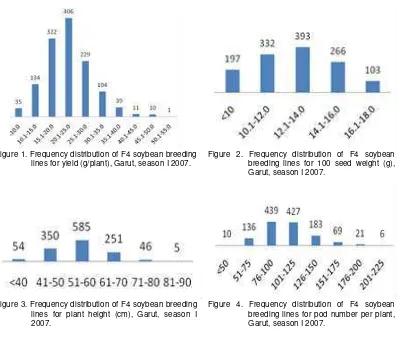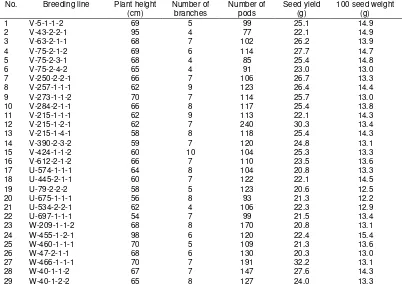Selection of F4, F5 and F6 Soybean Breeding Lines for High Yield
and Large Seed Size
Darman M. Arsyad
a*, Asadi
ba
Central Institute for Agricultural Technology Assessment and Development, Bogor, Indonesia b
Research Institute for Agricultural Biotechnology and Agricultural Genetic Resources, Bogor, Indonesia * Corresponding author: Central Institute for Agricultural Technology Assessment and Development,
Bogor, Indonesia
Tel.: +62-251-8351277; Fax: +62-251-8350928 [email protected]
Abstract
The first step in a cultivar development is to form a population with genetic variability for the characters of interest. This is done by hybridization of genetically different parents. Hybridization was made to combine the characters of high yield potential, wide adaptability, desirable agronomic characters, and large seed size by using cv. Tanggamus, Sibayak, Argomulyo, Anjasmoro, Panderman and Local Tegal. Amount of 4800 F4 lines originated from five single cross combination were planted in rice field, Sukawening, Garut District, West Java on early dry season 2007. Pedigree method of selection was used. Each line was grown in one row of three meters length and 40 cm between rows. There was a high variability on agronomic characters (plant height, pod number, seed yield and seed size). Amount 1311 F5 lines were selected and grown in the same location on late dry season 2007. Amount of 540 F6 lines were selected and grown in the same location on early rainy season 2007/2008. Sixty-two F7 lines were selected, and 42 lines among them had high yield and large seed size.
Keywords: high yield, large seed size, soybean breeding lines
Introduction
Breeding for high yield potential is generally the major goal in any breeding program including soybean. Breeding for high yield potential is inextricably linked with breeding for other characteristics. Today the preferences of users (farmers and craftsmen tempeh and tofu) were more likely to require large varieties of soybean seed. Craftsmen tempeh and tofu have long accustomed to using large seed soybean imports, so that preferences are now a lot towards the large seed.
To meet user demand, then breeding programs to produce varieties of soybean large seed in major need of attention. A number of varieties of large seed soybean have been available such as Argomulyo, Burangrang, Anjasmoro, and Grobogan (Hermanto et al., 2009).
As an effort to produce new varieties of soybeans that are superior to the existing varieties, a number of crossing (hybridization) between soybean genotypes of high yield potential, quite broad adaptability, many pods and smaller seed size with the genotypes of relatively low yield potential, narrow adaptability, few pods, and large seed size, and were carried out in 2004 (Arsyad et al. 2005).
This study aimed to: (a) obtain expected breeding lines better than the existing varieties, which possess higher yield potential, desirable agronomic traits and has a large or slightly larger seed size, and (b) study the behavior of the relationship among traits in soybean.
Materials and Methods
Plant Materials
the 1311 F5 breeding lines wich were selected from the F4 lines in season I, were grown and then as many as 540 F6 lines were selected. Those 540 F6 lines were grown in season III.
Methods
Pedigree method based selection was used in each generation (Fehr, 1987). In each season, each breeding lines was grown as a single row with 1.5 meters length. Spacing between rows (lines) were 40 cm and 10 cm within rows, and one seed/hole. Intensive techniques cultivation involves fertilizing with 75 kg urea, 200 kg SP36, and 150 kg KCl per ha, controlling of weeds, pests and diseases were carried out. Irrigation was applied, if there is no rain. The selection criteria was an ideal plant type,i.e. sturdy plants (not fall), plant height > 70 cm with 4-5 branches, medium leaf size, determinate type, more than 70 pods/plant and large pods. Selection procedure was done as follows: First, selected the good rows of plants, and secondly, selected the 3-5 plants in selected row that meet the selection criteria. Each selected individual plant was a new breeding line to the next generation. Data analysis was done by creating the frequency distribution of selected breeding lines, calculate the mean and standard deviation for the observed characters of each population, as well as t test for mean population comparation (Gomez & Gomez 1984, Sugiyono 2009).
Results and Discussion
Selection of F4 Lines
Before time to harvest, around 1600 lines was selected and then as many as 1311 lines was selected based on yield and seed quality. Only breeding lines derived from three crossing combinations were selected. Those were the crosses between Sibayak x Tegal (Code V), Tanggamus x Tegal (Code U) and Sibayak x Argomulyo (Code W). The other two crosses (Tanggamus x Anjasmoro and Sibayak x Panderman) derived inferior progenies. .
Frequency distribution of selected breeding lines based on crop yield are presented in Figures 1. The range of lines seem still very wide, ranging from less than 10 g to more than 50 g/line, with the highest frequency was in the range of 21-25 g/line. Genotype of parents produuced average yield of less than 20 g/genotype. This indicated the presence of transgressive segregation on the breeding materials. Variability was also found in the seed size (100 seed weight), plant height, and number of pods (Figure 2-4). The selection would be effective when there was wide phenotypic variability among breeding lines. This was understandable because the selected lines were still at F4 generation and was not selected since F2. The frequency of heterozygous individuals at a locus was 50% in F2 (Fehr 1983), and because the selection has not been done since the F2, therefore the heterozygote frequency in the F4 was still high (50%).
Breeding lines derived from Sibayak x Tegal cross have an average higher yields, larger seed, higher plant, but the number of pods is less than the breeding lines derived from Tanggamus x Tegal and Sibayak x Argomulyo (Table 1). No yield different between breeding lines derived from Tanggamus x Tegal and Sibayak x Argomulyo. Breeding lines derived from Sibayak x Tegal has larger seed size compared to the breeding lines derived from Tanggamus x Tegal and Sibayak x Argomulyo. Breeding lines derived from Sibayak x Argomulyo had a relatively smaller seed size compared to the other two cross combinations, but it had more pods per plant. It appears a tendency that the breeding lines of a large seed pods had fewer seeds, while breeding lines of moderate or relatively small seed pods had more seeds.
Although the selection in this study was only based on phenotypic values, it was expected to be quite effective to gain the best selected lines, which is expected to produce good progenies. The progress of the selection is determined by phenotypic variability, heritability values and selection intensity (Falconer, 1967). Agronomic characters such as plant height, number of branches and number of pods support high capacity of selected the breeding line.
Figure 1. Frequency distribution of F4 soybean breeding lines for yield (g/plant), Garut, season I 2007.
Figure 2. Frequency distribution of F4 soybean breeding lines for 100 seed weight (g), Garut, season I 2007.
Figure 3. Frequency distribution of F4 soybean breeding lines for plant height (cm), Garut, season I 2007.
Figure 4. Frequency distribution of F4 soybean breeding lines for pod number per plant, Garut, season I 2007.
Table 1. Mean and standar deviation of seed yield, 100 seed weight, plant height, and number of pods per plant of F4 lines originated of three single cross in rice field at Sukasono Village, Sukawening Subdistrict, Garut District, early dry season of 2007
Population Number
of lines
Seed yield (g)
100 seed weight (g)
Plant height (cm)
Number of pods / plant
V (Sibayak x Tegal) 490 24a ± 7.1 14.1a ± 2.1 58a ± 9.2 97b ± 25.4 U (Tanggamus x Tegal) 400 22b ± 6.8 12.6b ± 1.9 51b ± 8.1 100b ± 24.4 W (Sibayak x Argomulyo) 401 22b ± 7.3 10.9b ± 2.2 56a ± 7.6 124a ± 29.5
Value in the same column followed by the same letter are not different at 0.01 probability level
Selection of F5 Lines
breeding lines produced higher yield than that of the best parent (Tanggamus). This indicated the presence of the transgressive segregation, i.e. breeding line yields were higher than that of both parents. The occurence also the same as the seed size (100 seed weight), which was as many as 88 breeding lines contained a rather large to large seed size (Figures 6). Plant height and number of pods showed a fairly high variability (Figure 7 and 8).
Breeding lines derived from Sibayak x Argomulyo had the higher average yields, higher plant height, and more pods per plant than those of the breeding lines derived from Tanggamus x Tegal and Sibayak x Tegal (Table 2). In contrast, breeding lines derived from Sibayak x Tegal produced average seed size larger than that of the breeding lines derived from Tanggamus x Tegal and Sibayak x Argomulyo. It was a tendency that the breeding lines of larger seed correlated with fewer pods, shorter plants and lower grain yield. The selection would be effective when the high variability occurred among breeding lines. A total of 62 breeding lines had high yield capacity (Table 3).
Figure 5. Frequency distribution of F5 soybean breeding lines for yield (g/plant), Garut, season II 2007.
Figure 6. Frequency distribution of F5 soybean breeding lines for 100 seed weight (g), Garut, season II 2007.
Figure 7. Frequency distribution of F5 soybean breeding lines for plant height (cm), Garut, season II 2007.
Figure 8. Frequency distribution of F5 soybean breeding lines for pod number per plant, Garut, season II 2007.
Selection of F6 Lines
Table 2. Mean and standar deviation of seed yield, 100 seed weight, plant height, and number of pods per plant of F5 lines originated of three single cross in ricefield at Sukasono Village, Sukawening Subdistrict, Garut District, late dry season of 2007
Population Number
Value in the same column followed by the same letter are not different at 0.01 probability level
Table 3. Performance of the best 62 F5 breeding lines in ricefield at Sukasono Village, Sukawening Subdistrict, Garut District, season II 2007
Value in parenthese is a range
Table 4. Agronomic performance and seed yield of 42 F6 soybean breeding lines selected in ricefield at Sukasono Village, Sukawening Subdistrict, Garut District, season III 2007
No. Breeding line Plant height Value in parenthese is a range
Acknowledgment
The authors acknowledge the support of the Indonesian Ministry of Research and Technology, who provided the funding for this research.
References
Arsyad DM, H Kuswantoro and Purwantoro. 2005. Hybridization, and selection penggaluran soybeans. Technical Report Research Institute for Crop Legumes and Tuber (In Indonesian).
Burton JW. 1983. Quantitative genetics: Results relevant to soybean breeding, p. 211-248. In JR Wilcox (Ed.): Soybean: Improvement, Production, and Uses. Second Edition, ASA, Wisconsin, No. 16 in series. Falconer DS. 1967. Introduction to Quantitative Genetics.Robert MacLehose and Company Limited, Glasgow.
GreatBritain. Pp 365.
Hermanto, D Sadikin and E Hikmat. 2009. Deskripsi Varietas Unggul Palawija 1918-2009. Indonesian Center for Food Crops Research and Development. Indonesian Agency for Agriculture Research and Development. Pp 330 (In Indonesian).
Fehr WR. 1983. Applied Plant Breeding. Dept. of Agronomy, Iowa State Univ. Ames. 174 p.
Gomez KA and AA Gomez. 1984. Statistical Procedures for Agricultural Research. 2nd Edition. Pp 680. Sugiyono 2009. Statistika untuk Penelitian. Alfabeta, Bandung. Pp 389 (In Indonesian).


